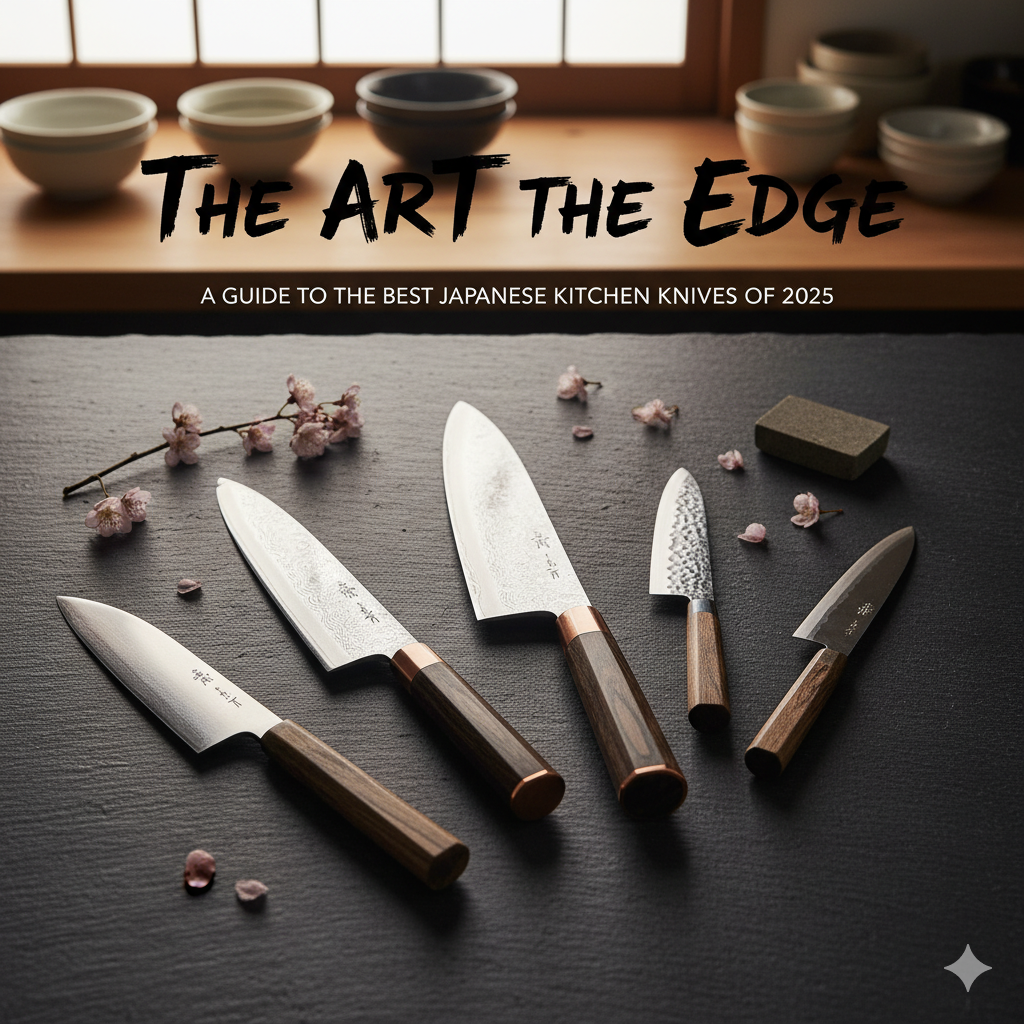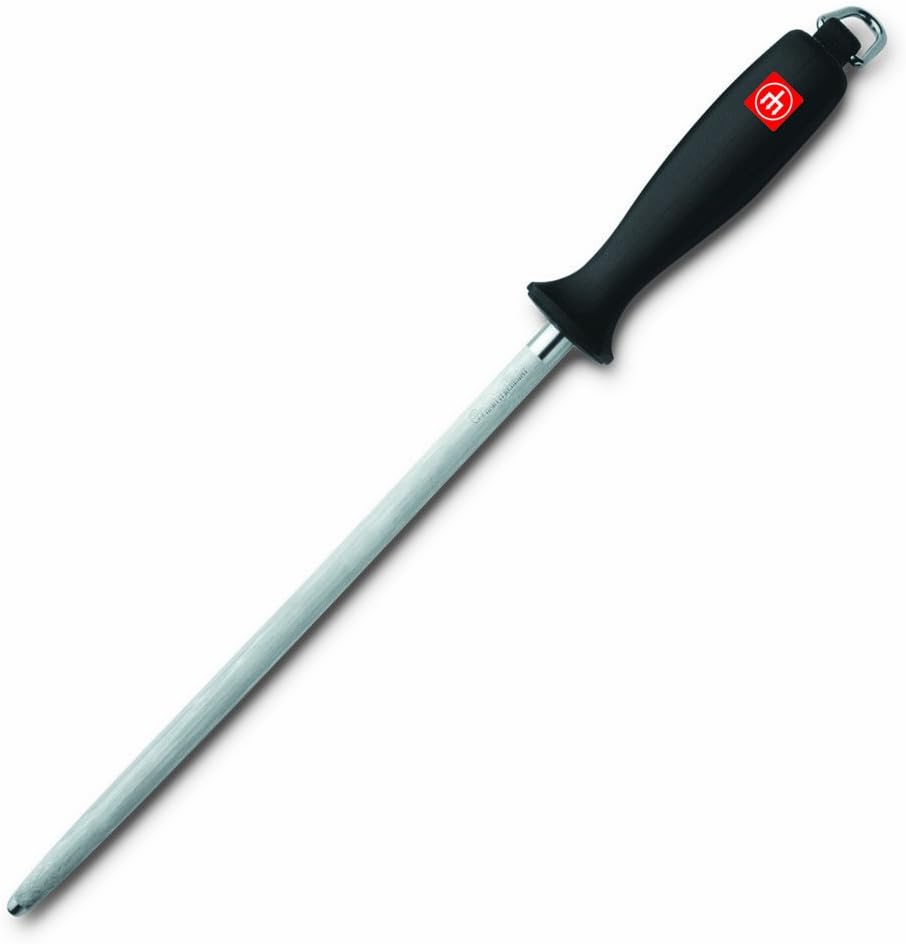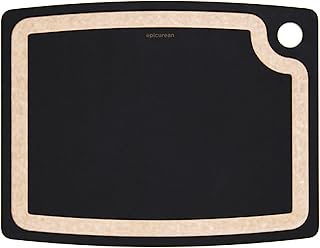The Art of the Edge: A Guide to the Best Japanese Kitchen Knives of 2025
If German knives are the powerful, indestructible workhorses of the kitchen, then Japanese knives are the precision-tuned racecars. Forged from a centuries-old tradition of samurai sword-making, a Japanese kitchen knife is an object of exquisite beauty and terrifying sharpness. It’s a tool designed not for brute force, but for finesse. Holding one is a different experience—they are lighter, harder, and thinner, capable of gliding through food with an eerie, surgical precision that has to be felt to be believed. Today, we explore this world of legendary sharpness to find the best Japanese knives for the modern American kitchen.

The Onion That Changed Everything: My First Cut with a Shun
I cooked for years with a trusty German chef’s knife. It was a fantastic tool, and I thought it was the sharpest a knife could be. I was wrong. My “eureka” moment happened at a friend’s house, a serious foodie who had just bought himself a beautiful Shun Classic chef’s knife. He asked for help prepping for dinner and handed it to me. The first thing I noticed was the weight—it was so much lighter and more nimble than my German blade. Then he handed me an onion.
I placed the blade on top and pushed down. There was no resistance. The knife didn’t split the onion; it simply *fell* through it, creating two perfectly silent, glassy-smooth halves on the board. I proceeded to dice it, and the knife produced tiny, uniform cubes with an effortless grace I had never experienced. It was like I’d been driving a pickup truck my whole life and someone had just handed me the keys to a Ferrari. That single experience sent me down the rabbit hole of Japanese cutlery, and this guide is the culmination of that passion—a deep dive into the art and science of the sharpest knives on Earth.
Decoding the Blade: How We Evaluated Japanese Knives
Japanese cutlery is a world of nuance, with a dizzying array of steel types, blade shapes, and forging techniques. To find the best, we had to go deep, evaluating these knives on the unique characteristics that define their legendary performance.
Our Core Philosophy: A great Japanese knife must deliver on its promise of superior sharpness and precision. It should feel light and agile in the hand, and its craftsmanship and materials should justify its premium status. It is a specialist’s tool that makes delicate tasks feel effortless.
- Steel Hardness & Type (The Cutting Core): This is the heart of a Japanese knife. We prioritized knives with a hard, high-carbon steel core, such as VG-10, VG-MAX, or SG2 (powdered steel). A high Rockwell hardness (60+ HRC) is essential for the blade’s ability to take and hold a razor-sharp, acute-angle edge.
- Edge Angle & Geometry: A key differentiator. We tested the factory edge, looking for a highly acute angle, typically between 12 and 16 degrees per side. The thinness of the blade behind the edge is also critical for reducing friction and allowing the knife to glide through food.
- Blade Construction & Cladding: Many high-end Japanese knives use a *san mai* construction, with a hard steel core protected by softer, stain-resistant steel cladding. We looked for beautiful and functional Damascus or hammered (*tsuchime*) finishes, which not only look stunning but also help reduce food sticking.
- Blade Shape & Type: We focused on the most versatile Japanese shapes for the Western kitchen, primarily the **Gyuto** (the Japanese equivalent of a chef’s knife) and the **Santoku** (a smaller, all-purpose knife). We evaluated how the shape lent itself to different cutting styles.
- Handle & Balance (The Wa-Handle): We assessed the handle’s material, shape, and comfort. Many Japanese knives feature a traditional octagonal or D-shaped “Wa-handle,” which offers excellent control. The balance is typically more blade-forward than German knives, which aids in a slicing or chopping motion. The famous rivalry between the top Japanese and German brands is a central theme in our popular Shun vs. Wüsthof deep dive.
The Cutting Edge: Top 5 Japanese Knives of 2025
If you’re ready to experience the pinnacle of sharpness, these five knives are the best in their class.
| Knife | Image | Brand | Best For | Check on Amazon |
|---|---|---|---|---|
| Shun Classic 8″ Gyuto |  |
Shun | Best Overall & Aesthetics | View Price |
| Miyabi Kaizen II 8″ Gyuto |  |
Miyabi | Best for Sharpness (SG2 Steel) | View Price |
| Global G-2 8″ Chef’s Knife |  |
Global | Best Modern Design & Hygiene | View Price |
| Tojiro DP 8.2″ Gyuto |  |
Tojiro | Best Value & Performance | View Price |
| MAC MTH-80 8″ Chef’s Knife |  |
MAC | The Professional’s Workhorse | View Price |
Masters of Steel: In-Depth Reviews of the Best Japanese Knives
We put these precision instruments to the test on everything from delicate herbs to dense root vegetables. Here is our detailed analysis of the finest blades from Japan.
1. Shun Classic 8-Inch Gyuto (Best Overall & Aesthetics)
For many Americans, the Shun Classic is their introduction to the world of high-end Japanese cutlery, and for good reason. It is a breathtakingly beautiful knife that also happens to be a top-tier performer. The blade features a proprietary VG-MAX “super steel” core, which is incredibly hard and holds a screamingly sharp 16-degree edge. This core is protected by 34 layers of stainless steel on each side, creating the iconic wavy Damascus pattern that Shun is famous for. This cladding isn’t just for show; it protects the core and helps food release from the blade.
The D-shaped PakkaWood handle is comfortable and provides excellent control. This knife is the complete package: stunning looks, premium materials, and razor-sharp performance. It’s the knife that perfectly illustrates the Japanese side of the epic Wüsthof vs. Zwilling vs. Shun debate.
Who is this best for?
The home cook or aspiring chef who wants a beautiful, high-performance Japanese knife from a reputable brand that offers a perfect blend of artistry and function.
- Stunning Damascus-clad blade
- Extremely sharp VG-MAX cutting core
- Excellent edge retention
- Comfortable and secure D-shaped handle
- Free lifetime sharpening service from Shun
Pros
- Hard steel can be prone to chipping if misused
- Premium price point
Cons
2. Miyabi Kaizen II 8-Inch Gyuto (Best for Sharpness)
Miyabi is the Japanese knife brand owned by the German giant Zwilling J.A. Henckels. This gives their knives a unique character: the pinnacle of Japanese blade craft combined with German engineering precision. The Kaizen II uses an FC61 steel core, which is a fine-carbide steel that is ice-hardened to a Rockwell of 61. This allows for an incredibly fine, sharp edge that also has surprising toughness. The core is wrapped in 48 layers of Damascus steel and features a beautiful hammered (*tsuchime*) finish that creates air pockets to prevent food from sticking.
The edge is hand-honed using the traditional *honbazuke* three-step process to a scalpel-like 9.5 to 12-degree angle. This is, put simply, one of the sharpest knives you can buy out of the box. It showcases a different approach to steel than a brand like Victorinox, as we discuss in our Victorinox vs. Zwilling article. It’s German precision meeting Japanese artistry.
Who is this best for?
The sharpness enthusiast who wants the most acute, precise edge possible in a beautiful, well-crafted package.
- Surgically sharp, hand-honed 9.5-12 degree edge
- Hard FC61 steel core offers amazing edge retention
- Beautiful hammered Damascus finish
- Extremely comfortable and durable PakkaWood handle
Pros
- Very acute edge is more delicate than a Shun
- Requires careful use to avoid chipping
Cons
3. Global G-2 8-Inch Chef’s Knife (Best Modern Design & Hygiene)
The Global G-2 is an icon of 20th-century design, famously beloved by chefs like Anthony Bourdain. Unlike other Japanese knives, it is stamped—not forged—from a single piece of proprietary CROMOVA 18 high-carbon stainless steel. The seamless transition from blade to handle is not just a striking design choice; it’s also incredibly hygienic, leaving no gaps for food to get trapped. The hollow handle is filled with sand to achieve a perfect, distinctive balance.
The blade is thin, light, and sharpened to a very acute angle, giving it that classic Japanese precision. It’s a different approach than forging, but the result is a nimble, ultra-sharp, and extremely durable knife that has been a favorite in professional kitchens for decades. It’s a true modern classic and one of the best chef knife brands for those who appreciate industrial design.
Who is this best for?
The design-conscious cook, the hygiene-focused chef, or anyone who loves a lightweight, perfectly balanced, and ultra-sharp blade with a unique modern aesthetic.
- Iconic, seamless, one-piece steel design
- Extremely hygienic and easy to clean
- Lightweight and perfectly balanced
- Razor-sharp CROMOVA 18 steel edge
- Highly resistant to stains and rust
Pros
- Dimpled steel handle can be slippery when oily
- Stamped construction lacks the heft some cooks prefer
Cons
4. Tojiro DP 8.2-Inch Gyuto (Best Value & Performance)
The Tojiro DP is a cult classic and perhaps the most recommended entry-level Japanese knife among serious chefs and knife enthusiasts. The reason is simple: it offers the performance of a $150+ knife for well under $100. The blade features a genuine VG-10 steel core (the same steel family as many Shun knives) sandwiched between two layers of softer, stain-resistant steel. It’s a true *san mai* construction that delivers a hard, sharp edge (60 HRC) with the durability of a composite blade.
The fit and finish aren’t as refined as a Shun or Miyabi, and the handle is a standard Western-style composite handle. But the performance of the blade itself is absolutely outstanding for the price. It’s a no-frills workhorse that puts all its value into the steel. For anyone wanting to experience true Japanese performance without the high price tag, the Tojiro is the undisputed king. It’s the perfect example of the best affordable chef knives philosophy.
Who is this best for?
The budget-conscious cook, the culinary student, or anyone who prioritizes pure cutting performance over aesthetics and wants the best value in Japanese cutlery.
- Incredible performance for the price
- Genuine VG-10 steel cutting core (60 HRC)
- Takes and holds a fantastic, sharp edge
- Durable, Western-style handle
Pros
- Less refined fit and finish
- Handle is functional but not as ergonomic as premium brands
Cons
5. MAC MTH-80 8-Inch Chef’s Knife (The Professional’s Workhorse)
MAC knives are often called the “hidden champions” of the professional kitchen. They offer a unique hybrid design that blends the best of German and Japanese philosophies. The MTH-80 is their flagship chef’s knife. It’s stamped from MAC’s proprietary high-carbon steel, which is hard enough to hold a sharp 15-degree edge but tough enough to resist chipping like a German knife. The blade is slightly thicker than a Shun but thinner than a Wüsthof, and it has a full bolster and a classic PakkaWood handle. The balance is perfect.
It’s famous for its “off-center” edge, where one side has a slightly larger bevel than the other, which is said to make it glide through food with less effort. It’s not as flashy as a Damascus-clad knife, but its pure cutting performance is legendary among pro chefs. It’s the ultimate practical choice, a perfect middle ground between the robust feel of the knives in our best German kitchen knives guide and the delicate nature of other Japanese blades.
Who is this best for?
The professional chef or serious home cook who wants a no-nonsense, ultra-sharp, yet highly durable Japanese knife that is built for daily, rigorous use.
- Hybrid design offers both sharpness and durability
- Extremely sharp out of the box
- Excellent balance and comfortable handle
- A favorite of professional chefs for decades
Pros
- Stamped blade lacks the aesthetic of forged Damascus
- Less brand recognition among home cooks
Cons
Your Japanese Knife Questions, Answered
What is the difference between German and Japanese knives?
The primary difference is their design philosophy. German knives are built for durability. They use tougher, slightly softer steel (57-58 HRC), are heavier, and have a wider 20-degree edge angle. They are the workhorses. Japanese knives are built for sharpness. They use harder, more brittle steel (60+ HRC), are lighter, and have a more acute 12-16 degree edge angle. They are precision instruments. We cover this in depth in our Guide to German Knives.
What does the Damascus pattern on Japanese knives do?
The beautiful, layered pattern on knives like the Shun Classic is called Damascus cladding. It’s made by forge-welding many layers of softer steel around a very hard central cutting core. It serves two purposes: first, it’s incredibly beautiful. Second, the softer, flexible outer layers act like a suit of armor, protecting the hard but brittle core from chipping and providing stain resistance.
Are Japanese knives hard to sharpen?
Because Japanese knives use harder steel, they can be more challenging to sharpen on traditional stones than their softer German counterparts. However, their hard steel also means they hold their edge for a very long time, so they require sharpening less frequently. Using a quality electric knife sharpener with a 15-degree setting is an excellent, easy way to maintain their razor edge. Whetstones are the traditional method but require practice.
What is a Gyuto vs. a Santoku?
A Gyuto is the Japanese version of the classic Western chef’s knife. It typically has a slight curve to the blade, making it versatile for both chopping and rock-chopping. A Santoku, which means “three virtues” (slicing, dicing, and mincing), is typically shorter, has a flatter edge, and a sheepsfoot tip. It excels at quick, downward chopping motions and is particularly great for vegetables.
The Final Cut: Embracing the Art of Sharpness
A Japanese kitchen knife is more than just a tool; it’s an invitation to a more precise, more graceful, and more artful way of cooking. The effortless way they glide through food can fundamentally change your experience at the cutting board, transforming prep work from a chore into a joy. While they demand respect and a bit more care than their German cousins, the performance they deliver is a worthy reward.
For the home cook who wants the perfect blend of stunning beauty and razor-sharp performance, the Shun Classic 8-Inch Gyuto is a timeless choice and our top recommendation. It’s the knife that has introduced millions to the magic of Japanese steel.
If your sole pursuit is the absolute sharpest edge out of the box, the Miyabi Kaizen II is a triumph of Japanese artisanship. And for the pragmatist who wants to experience that legendary sharpness without the premium price, the Tojiro DP Gyuto is the undisputed champion of value.
Choose any knife from this list, and you’re not just buying a kitchen utensil. You’re investing in a piece of a rich, centuries-old tradition of craftsmanship that will elevate every meal you create.























